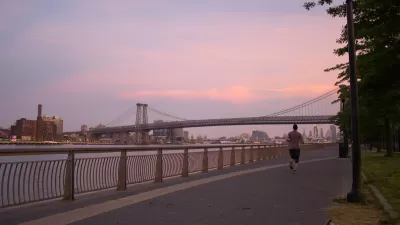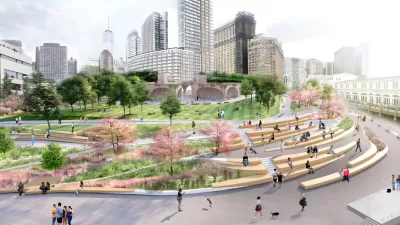A debate over how to protect the East River waterfront from Sandy-level flooding and storm damage has delayed the project as community activists decry the city's last-minute change of plans.

After Hurricane Sandy devastated Lower Manhattan in 2012, a federal grant competition sought out resilience projects that would protect East River Park and the surrounding neighborhood from future storms and flooding. A major recipient was a plan called the BIG U, which proposed natural barriers and berms that would allow occasional flooding and protect buildings. But rather than going ahead with the project, writes Michael Kimmelman, the city pulled the plug in 2018, citing cost concerns and proposing an alternate plan that would raise the coastline by adding more landfill instead.
Kimmelman outlines the history of East River Park and the public housing developments dotting the East River waterfront, and describes the community activists working to develop resilience plans for the area. After years of public consultation, the city's decision to change the proposed plan at the last minute and disregard community input has led to a contentious debate over the future of the area. The controversy divided the community and slowed progress on essential infrastructure needed to protect local residents and buildings.
Kimmelman describes the situation as a tension between community input and perceived expertise, between the inclusion of all voices and the urgent need for flood mitigation measures. After multiple delays due to lawsuits, design changes, and the pandemic, the city is moving forward with its new plan, scheduled for completion in 2026. The new levee is projected to protect the neighborhood until 2050.
You can also listen to the article on The Daily podcast.
FULL STORY: What does it mean to save a neighborhood?

Study: Maui’s Plan to Convert Vacation Rentals to Long-Term Housing Could Cause Nearly $1 Billion Economic Loss
The plan would reduce visitor accommodation by 25,% resulting in 1,900 jobs lost.

North Texas Transit Leaders Tout Benefits of TOD for Growing Region
At a summit focused on transit-oriented development, policymakers discussed how North Texas’ expanded light rail system can serve as a tool for economic growth.

Using Old Oil and Gas Wells for Green Energy Storage
Penn State researchers have found that repurposing abandoned oil and gas wells for geothermal-assisted compressed-air energy storage can boost efficiency, reduce environmental risks, and support clean energy and job transitions.

Santa Barbara Could Build Housing on County Land
County supervisors moved forward a proposal to build workforce housing on two county-owned parcels.

San Mateo Formally Opposes Freeway Project
The city council will send a letter to Caltrans urging the agency to reconsider a plan to expand the 101 through the city of San Mateo.

A Bronx Community Fights to Have its Voice Heard
After organizing and giving input for decades, the community around the Kingsbridge Armory might actually see it redeveloped — and they want to continue to have a say in how it goes.
Urban Design for Planners 1: Software Tools
This six-course series explores essential urban design concepts using open source software and equips planners with the tools they need to participate fully in the urban design process.
Planning for Universal Design
Learn the tools for implementing Universal Design in planning regulations.
Ascent Environmental
Borough of Carlisle
Institute for Housing and Urban Development Studies (IHS)
City of Grandview
Harvard GSD Executive Education
Toledo-Lucas County Plan Commissions
Salt Lake City
NYU Wagner Graduate School of Public Service





























